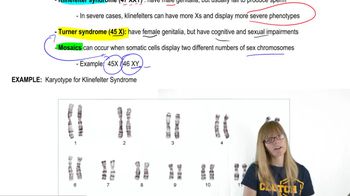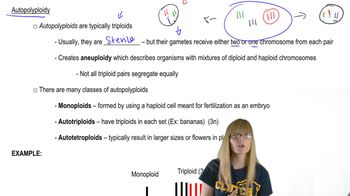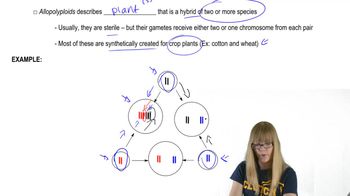Table of contents
- 1. Introduction to Genetics51m
- 2. Mendel's Laws of Inheritance3h 37m
- 3. Extensions to Mendelian Inheritance2h 41m
- 4. Genetic Mapping and Linkage2h 28m
- 5. Genetics of Bacteria and Viruses1h 21m
- 6. Chromosomal Variation1h 48m
- 7. DNA and Chromosome Structure56m
- 8. DNA Replication1h 10m
- 9. Mitosis and Meiosis1h 34m
- 10. Transcription1h 0m
- 11. Translation58m
- 12. Gene Regulation in Prokaryotes1h 19m
- 13. Gene Regulation in Eukaryotes44m
- 14. Genetic Control of Development44m
- 15. Genomes and Genomics1h 50m
- 16. Transposable Elements47m
- 17. Mutation, Repair, and Recombination1h 6m
- 18. Molecular Genetic Tools19m
- 19. Cancer Genetics29m
- 20. Quantitative Genetics1h 26m
- 21. Population Genetics50m
- 22. Evolutionary Genetics29m
6. Chromosomal Variation
Chromosomal Mutations: Aberrant Euploidy
Problem 9a
Textbook Question
Mating between a male donkey (2n=62) and a female horse (2n=64) produces sterile mules. Recently, however, a very rare event occurred—a female mule gave birth to an offspring by mating with a horse.
Why is it very unlikely that the offspring will have fully horse-like genetic characteristics?
 Verified step by step guidance
Verified step by step guidance1
<span>Identify the chromosome numbers of the parents: a male donkey has 62 chromosomes (2n=62) and a female horse has 64 chromosomes (2n=64).</span>
<span>Understand that a mule, being a hybrid of a donkey and a horse, will have a chromosome number that is the sum of half the chromosomes from each parent: (31 from the donkey + 32 from the horse = 63 chromosomes).</span>
<span>Recognize that mules are typically sterile because they have an odd number of chromosomes (63), which prevents them from forming balanced gametes during meiosis.</span>
<span>Consider the rare event where a female mule gives birth, indicating some form of chromosomal anomaly or fusion that allowed for viable gamete formation.</span>
<span>Conclude that the offspring is unlikely to have fully horse-like genetic characteristics because it inherits a mix of chromosomes from both the mule (which has a mix of donkey and horse chromosomes) and the horse, leading to a unique genetic composition.</span>
Recommended similar problem, with video answer:
 Verified Solution
Verified SolutionThis video solution was recommended by our tutors as helpful for the problem above
Video duration:
2mPlay a video:
Was this helpful?
Key Concepts
Here are the essential concepts you must grasp in order to answer the question correctly.
Hybrid Sterility
Hybrid sterility occurs when the offspring of two different species, such as a mule (a cross between a horse and a donkey), are unable to reproduce. This is often due to differences in chromosome number and structure, which can lead to improper pairing during meiosis, resulting in gametes that are not viable. In this case, mules are typically sterile because they have an intermediate number of chromosomes (63) that cannot evenly segregate during reproduction.
Recommended video:
Guided course

Drosophila P Element
Chromosome Number and Compatibility
The chromosome number and compatibility between species play a crucial role in determining the viability of offspring. Horses have 64 chromosomes, while donkeys have 62, leading to mules having 63 chromosomes. This odd number complicates the formation of gametes, making it unlikely for a mule to produce offspring with a complete set of horse-like genetic characteristics, as the genetic material may not align properly during fertilization.
Recommended video:
Guided course

Human Sex Chromosomes
Genetic Recombination and Expression
Genetic recombination is the process by which genetic material is shuffled during meiosis, leading to offspring with a mix of traits from both parents. In the case of a mule mating with a horse, the recombination of genes may not produce a viable combination that resembles a horse due to the differences in chromosome structure and number. As a result, even if an offspring is produced, it is unlikely to exhibit fully horse-like characteristics due to the genetic incompatibility.
Recommended video:
Guided course

Penetrance and Expressivity

 8:42m
8:42mWatch next
Master Aberrant Euploid with a bite sized video explanation from Kylia Goodner
Start learning



